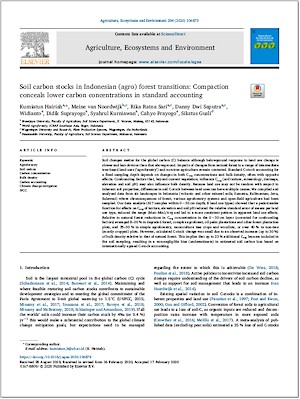| Journal Article |
 |
|
| Article Title | Soil carbon stocks in Indonesian (agro) forest transitions: Compaction conceals lower carbon concentrations in standard accounting | | Author | Kurniatun Hairiah, Meine van Noordwijk, Rika Ratna Sari, Danny Dwi Saputra, Widianto, Didik Suprayogo, Syahrul Kurniawan, Cahyo Prayogo and Sikstus Gusli | | Year | 2020 | | Journal Title | Agriculture, Ecosystems and Environment | | Volume | 294 | | Pages | 1-12 | | Call Number | JA00740-20 |
|
| Abstract: |
| Soil changes matter for the global carbon (C) balance although belowground response to land use change is slower and less obvious than that aboveground. Impacts of changes from natural forest to a range of intermediate tree-based land uses (‘agroforestry’) and non-tree agriculture remain contested. Standard C-stock accounting for a fixed sampling depth depends on changes in both Corg concentrations and bulk density, often with opposite effects. Confounding factors that, beyond current vegetation, influence Corg (soil texture, minerology, drainage, elevation and soil pH) may also influence bulk density. Because land use may not be random with respect to inherent soil properties, differences in soil C-stock between land uses can have multiple causes. We compiled and analysed data from six landscapes in Indonesia (volcanic and other mineral soils; Sumatra, Kalimantan; Java, Sulawesi) where chronosequences of forest, various agroforestry systems and open-field agriculture had been sampled. Our data analysis (617 samples within 0−30 cm depth; 8 land use types) showed that a pedotransfer function for effects on Corg of texture, elevation and soil pH reduced the relative standard error of means per land use type, reduced the range (Max–Min)/Avg and led to a more consistent pattern in apparent land use effects. Relative to natural forest reductions in Corg concentration in the 0−30 cm layer (corrected for confounding factors) averaged 8–20 % in degraded forest, complex agroforest, oil palm plantations and older forest plantation plots, and 25–30 % in simple agroforestry, monoculture tree crops and woodlots, or over 40 % in non-tree (mostly cropped) plots. However, calculated C-stock change was small due to an observed increase (up to 30 %) of bulk density relative to that of natural forest. This implies that up to 23 % additional Corg became included in the soil sampling, resulting in a non-negligible bias (underestimate) in estimated soil carbon loss based on internationally agreed C-stock accounting. |
|